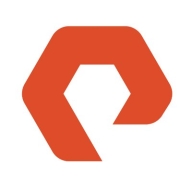


Find out in this report how the two All-Flash Storage solutions compare in terms of features, pricing, service and support, easy of deployment, and ROI.


Pure Storage FlashArray//X is the world’s first enterprise-class, all-NVMe flash storage array. It represents a new class of storage – shared accelerated storage, which is a term coined by Gartner – that delivers major breakthroughs in performance, simplicity, and consolidation.
NetApp AFF A-Series is ideal for high-performance storage in enterprise environments. It efficiently handles large-scale data and provides reliable storage for virtual machines, databases, and critical applications.
NetApp AFF A-Series stands out for its speed, reliability, and robust data protection features. Users find its management easy and appreciate the efficiency in handling large workloads. Its seamless integration with cloud services and high data transfer speeds with reduced latency enhance its appeal. Scalability and support for various applications make it a top choice for enterprises. However, there is room for improvement in documentation, technical support response time, and third-party application integration.
What are the standout features of NetApp AFF A-Series?NetApp AFF A-Series is implemented across industries to support virtual machines, large databases, and critical applications. It's particularly valuable in financial services for fast transaction processing, in healthcare for managing extensive patient records and imaging data, and in tech companies for supporting development environments and big data analytics.
Pavilion HyperParallel Data Platform
The Pavilion HyperParallel Data Platform™ dramatically accelerates what organizations achieve by delivering universally unmatched storage performance, in an incredibly compact solution while reducing data center costs and complexity. Unrivaled flexibility for multiple data types and protocols, along with broad ecosystem integration, ensure that every customer has choice and control.
What is the Pavilion HyperParallel Data Platform
The Pavilion HyperParallel Data Platform is comprised of the Pavilion HyperParallel Flash Array™ and Pavilion HyperOS™. The Pavilion HyperParallel Flash Array leverages a unique, switch-based architecture to create a multi-controller solution that delivers an unmatched combination of high performance, ultra-low latency, and storage density. Pavilion HyperOS is a powerful, purpose-built storage operating system designed to unlock the power of the multi-controller Pavilion HyperParallel Flash Array, which delivers scalability and flexibility that no other solution can offer.
Pavilion HyperParallel Data Platform Data Sheet
Download the Pavilion HyperParallel Data Platform data sheet. Updated: December 2020
We monitor all All-Flash Storage reviews to prevent fraudulent reviews and keep review quality high. We do not post reviews by company employees or direct competitors. We validate each review for authenticity via cross-reference with LinkedIn, and personal follow-up with the reviewer when necessary.